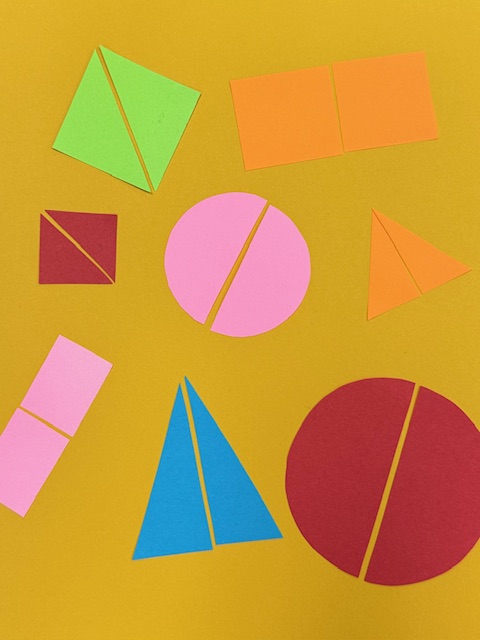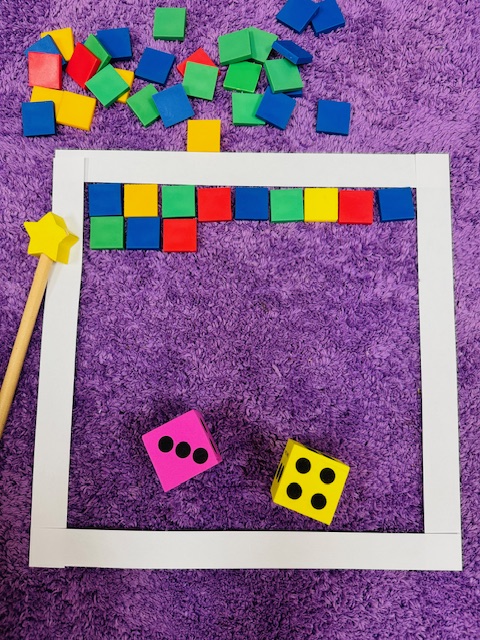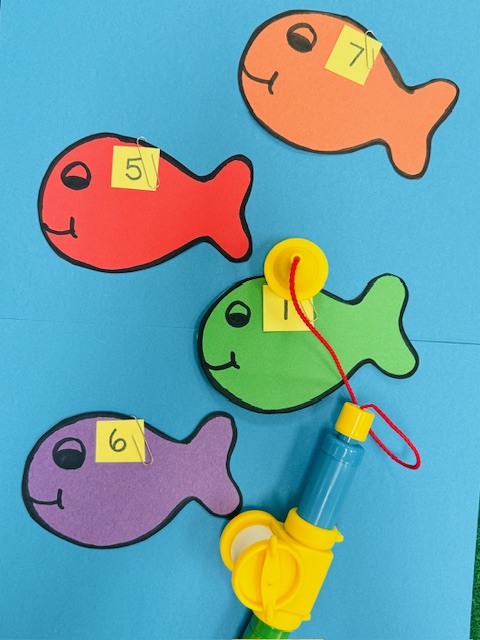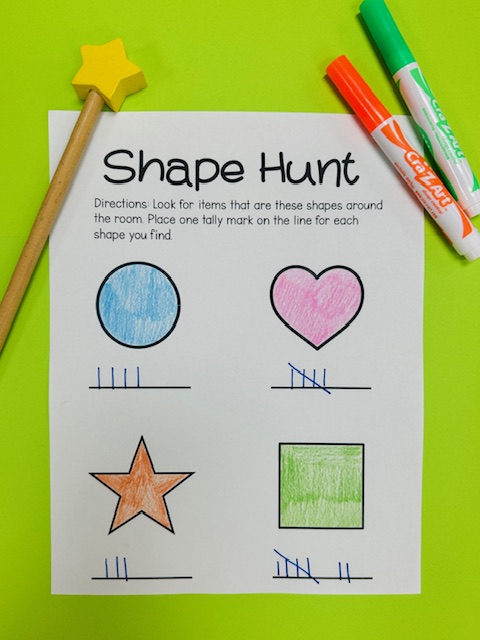
Young children like to be active. Getting their hands on and into things, moving their bodies, and just getting up and out of their seats are all natural and engaging things that kids want to do both at home and in school. So as effective teachers, the more we tap into that inclination, the better for us and for them. Kids learn by doing, whether it is baseball or dinosaurs or math. So let’s do some math!
Here are some fun, engaging, and active math games and activities kids will enjoy while engaging in all kinds of age-appropriate math. They’ll have fun, get moving, and learn a lot.
1. Find My Shape

Prepare a class set of paper geometric shapes that you want students to focus on. You should have multiples of various shapes and use different-color paper. Make them fairly large and then cut each one in half. One half of a shape is given to each student. When you say “begin,” students should get up and move around the room, seeing if they can find a matching half for their shape. Once they do, have them all sit down with their shapes and describe attributes of the shapes such as number of sides, straight or curved, how many corners, and the names.
2. The Money Boat
If you’re looking for active math games to teach money skills, try this one. Ready to practice adding up some mixed coin sets? Use a plastic wash tub or kiddie pool and fill it halfway with water. Put an empty plastic container in the water. Mark off a tape line 3 or 4 feet from the tub or pool. Form your class into groups of three, and give each team a set of real or plastic coins. Students use an underhand toss to get coins in the floating “Money Boat.” Whatever lands in the boat is added up by the team. Whichever team has the most money is the winner.
3. Valentine Math
Make a set of heart-shaped cards, enough for one heart per student desk. Write an addition or subtraction problem on the front and the answer on the back (for self-checking). Label each heart with a letter from A to Z. The heart card stays on the student’s desk.
Make a grid sheet for each student. Label each box of the grid with a letter from A to Z so that as students solve each math problem, they record the answer in the corresponding box.
Students will start with the heart that’s on their desk first. They’ll solve that problem, and write the answer in the corresponding box on the grid. Then they’ll check on the back and correct if necessary. When you say rotate, students rotate to the next desk and solve that problem the same way. Continue the rotation until all the students have solved all the problems.
4. George Washington’s Feet
Bring in a men’s size 13 shoe or boot and share the shoe and this fact with students: President George Washington wore a size 13 shoe like this one! Now give each student a turn tracing the shoe or boot on a piece of paper. Then have them step inside with their own foot heel-to-heel with Washington’s and trace their own foot.
Provide each student with a ruler and ask these questions: “How long do you think George Washington’s foot was?” and “How much bigger was his foot than yours?” Have students write their answers on that same paper and share the results as a class.
5. How Long Is the Room?
Tell students you would like them to find out how long the room is, but that they won’t be using rulers, yardsticks, or measuring tapes. Instead, they will use their feet. Model this yourself by going heel-to-toe across the room and counting aloud with the class. Record your answer. Before they begin, ask if they think your measurement will be the same as theirs. Discuss.
Then have students work with a partner as they measure the distance from one end of the classroom to the other. The partner will count and record the feet. After all students have had a turn to measure using their feet, then have them work again in pairs using a ruler to measure the same distance. Ask: What are the differences? Why are there differences? How does using a standard ruler help us measure?
6. Cotton Ball Olympics
If you’re looking for active math games to play during an Olympics year, try this one. Give each student a cotton ball and divide the class into groups of three or four. The Olympics can be held inside or outside. Have students compete in simple events such as: Cotton Ball Overhand Throw, Cotton Ball Underhand Throw, Cotton Ball Kick, or Cotton Ball Blow (using a straw). Students will stand behind a tape line, move that cotton ball, and then the student or another student (taking turns) measures the distance from the starting line to where the cotton ball landed. Finally, the student records the distance on a prepared sheet. When everyone is finished, you can tally all the results in chart form to see the range of results (and maybe hand out Olympic medals).
7. Heaviest Book in the Room
Have several scales available for this activity, including balance scales, bathroom scales, and kitchen spring scales. Put students in groups of three to find and weigh the heaviest book in their desks. Record the weights. Share the findings with the class, and record the heaviest book.
Next, have students follow the same procedures to find the heaviest book in the classroom. Compare all results and weigh the finalists to determine the heaviest book in the classroom.
8. Inchworm Exploration
Prepare a 1-inch-long inchworm drawing on paper for students to color and cut out. These can then be glued onto a craft stick to keep them sturdy. Have students walk around the classroom with their inchworm measuring stick to find things that are smaller than or just larger than 1 inch. They should write these down on lined paper and share with the class at the end.
9. Becoming the Equation
Students put themselves into the correct positions to create the correct multiplication equation.
On large cards or construction paper, write the following: “factor” (on two of them), “product” (on one of them), a multiplication symbol (on one of them), and an equal sign (on one of them). Also make cards for 0 to 100 (one number per card).
Demonstrate by picking up three number signs that form a correct multiplication equation, for example, 2, 5, and 10. Choose five students, give the first student the 2 card and a “factor” card; give the second student the “multiplication symbol” card; give the third student the 5 card and a “factor” card; give the fourth student the equal sign card and the fifth student the 10 card. Have students stand shoulder to shoulder in the correct sequence holding their cards up. The class will see the correct equation.
Once this has been demonstrated, have the next group of five students select their own numbers and arrange themselves with the vocabulary and signs to create a correct multiplication equation.
10. Egg Carton Adder
Ask students to bring in an empty egg carton. Have them open the carton and with a marker or crayon, write one number 0 through 11 in each of the “egg spaces.” They will also need two small, light objects to toss into the carton such as Ping-Pong balls, buttons, beans, math counters, etc.
Students will work in pairs, putting the egg cartons on the floor side by side. One student tosses their objects into the egg carton spaces and adds the two numbers the objects have landed on. The other student does the same with their objects. Whoever gets the highest number wins that round. Play can be set for a certain number of rounds or a set amount of time. Students can total up their scores at the end of the rounds or when time is up and see who has the highest number.
11. Fill My Square

This is a good partner game to practice multiplication. Students will need two dice or two number cubes and a sheet to record their factors and products. Tape a square on the floor that is 1 foot by 1 foot for each player. Provide a container of at least 100 counting chips or bottle caps.
Each player rolls their two dice and multiplies them to get a product. From a container of circular counters like bottle caps or counting chips, players take that many. They then lay them into the square, touching each other but not covering any. The first player to fill their square wins.
12. Multiplication Relay Race
Kids like to race. Here’s a race that gets them multiplying. Prepare a set of large cards or sheets of construction paper with multiplication problems without products. Prepare another set of large cards or sheets of construction paper with the products matching the first set.
At the starting line, place the set of problem cards in a stack face down. At the relay “turning point,” have the product cards laid out on the floor or large table area face up. When it is a student’s turn, they pick up the top card, run to the turning point, and find the correct product. A teacher or helper will quickly check to make sure the product is correct. Then the student runs back to the end of their team’s line and sits down.
Whichever team is all seated first is the winning team. All players on both teams will read their equations out loud.
13. Number Toss
This is a good inside or outside game for young learners to practice number identification. Attach number cards to plastic bins. Tape a line some distance from the bins. Have a good amount of soft items to be tossed (beanbags or pom-poms, for example). Students form teams and take turns at the line trying to toss the correct number of items into the correct bin. This is a non-competitive game—players work together as a team. When they are finished, they sit down together, while the teacher checks to see that the items match the number. Adjust the distance from bins according to age and ability.
14. Sticks and Stones
This is good motivating practice for early-age counters. Take a walk on the playground and look for small sticks and stones. Have students collect these in a bag and bring them into the classroom. Then hand out a set of number cards from 1 to 10 and spread them out on a rug or table. Each student should then reach into their bag and place a set of sticks or stones that match that number just under the card.
15. Fish for a Number

Get a set of number cards from 1 to 10 and laminate them. Make a “fishing pole” with a stick or dowel, string, and a magnet. Cut out paper or foam fish, paper for dry land, and foam for a kiddie pool. Put a paper clip on each fish and a number card as well. Have the students “fish” for numbers in the correct order, pulling them off and placing them in a row until they catch all the numbers from 1 to 10.
16. Long Lines
This is an outside activity that lets kids practice using measuring tapes. Have students use sidewalk chalk to make a few long lines without measuring, just drawing until you say stop. Using measuring tapes, students work together as partners to measure and record the length of their lines. Students can write their results on top of their lines. Practice how to write and record feet and inches when you model this.
17. Number Dash
On the playground, use chalk to write a series of numbers you want students to work on. There should be one number for each student and one bonus number. Have students line up on a line two arm lengths apart. Go down the line and whisper a number that is chalked out there in the ear of each student. When you say go, students dash to the number you whispered to them. Have them call out the number they are standing on and then ask everyone to call out the bonus number. Each round, whisper a different number in each player’s ear. This is simple but really gets kids excited.
18. Place Value Toss
Have four bins or boxes labeled Ones, Tens, Hundreds, and Thousands. Adjust according to grade level and ability. Students will take turns throwing various numbers of beanbags into the bins, then writing the resulting number. Start with seven bags. For example, if I throw two into the hundreds, two into the tens, and three into the ones bin, my number is 223. I would write the number in numeral and word form on my record sheet then my partner takes a turn.
19. Paper Plate Facts
Buy a package of paper plates and on each one, write a number. Pass out one paper plate to each student. Have them all stand up and explain, “When I say go, I want you to find two other people in the room who with their numbers and your number, you can create an addition or subtraction fact. Then sit down together so we know you are done. For example, if you have 5, your friend Jane has 9, and I have 4, we could form 5 + 4 = 9.”
Once all students are sitting, have each group stand up, show their numbers, and state their fact. Do this several times in a row. Players can choose each time to add or subtract. For example, 4, 5, 9 becomes 4 + 5 = 9 and 9 – 5 = 4.
20. Giant Number Lines
Kids like really small things like miniatures and really big things. Here’s a simple activity that’s fun just because it uses something big. Use sidewalk chalk outside or painter’s tape inside to make a large number line (about 12 inches between each number). By calling out numbers on the line to kids, you can practice a variety of skills such as adding on, subtraction, counting backward, or identifying odd and even numbers.
21. Fact Movers
Provide pairs of students with a regular pair of dice and a cube (wood or paper) with actions written on all six sides, such as hop, spin around, touch toes, clap, touch knees, or snap fingers. Students take turns rolling all three cubes at the same time and create an addition or subtraction fact that they solve. Then they must do the action rolled that many times.
22. Water Balloon Number Splash
Looking for active math games for a hot day? Fill water balloons and write a number on each one. Outside on the playground, use chalk to write numbers to correspond to the balloon numbers. Each student chooses a balloon, then finds the chalk number and throws the balloon on the matching number.
23. Hands of Time
On the playground, use chalk to draw a giant clock with hours and minutes marked. Pair up students and assign one to show the hour and another to show the minutes. Call out a time to be practiced. Students move to their positions on the clock. To make it more challenging, have an additional time added or subtracted. For example, begin with 3:18, then say, “Now show 17 minutes later.”
24. How Far Can Your Animal Jump?
Here’s a good activity for inside or outside. To practice measuring distances, tell students they are to jump like certain animals: frogs, kangaroos, grasshoppers, and so on. Tape a starting line. Working in pairs, one student makes the jump while the partner marks it with chalk or tape. Then they work together to measure the distance with a ruler, yardstick, or tape measure, and record it on a piece of lined paper with a pencil.
25. Beanbag Number Toss
On the playground, use chalk to write numbers in a large circle. Students surround the circle. Tell students you will call out a number and they are to take a beanbag and try to toss it on that number. If they get it on the correct number, they score that many points. You can also play this with two beanbags and have students add or subtract the two numbers.
26. Flash Card Dash
Flash cards aren’t boring when you make them into active math games! Tape two rows of flash cards with math equations on them on the floor. This can be done as a competition between two students, or it can be done independently. Students move as quickly as they can to touch the flash card with their foot, give the answer, have someone check it, and then move on to the next card. Whoever finishes first is the winner. A student working independently can try to beat their previous time.
27. Beach Ball Fact Toss
On a beach ball, use a permanent marker to write numbers for skills to be practiced. Have students form a circle with you in the middle. Toss the beach ball to a student and wherever their thumbs land, use those numbers to add, subtract, or multiply. You can change the operation as you make the toss. It keeps players alert and listening.
28. Dance Your Answer
Incorporate dancing into your active math games for fun and exercise. Create a number mat (with digits 0 to 9) large enough for a student to stand on a number. Ask an addition or subtraction fact with a two-digit answer. Call out the fact. Students take turns playing. The student playing will put their left foot on the tens place number and their right foot on the ones place number. They can do a dance move as they are on their answer.
29. Stack Your Answer
Get a package of plastic caps and using a permanent marker, write addition and subtraction facts without answers on them. Stack them in one tower, one on top of the other. This is a good game for three or four students. Students take turns pulling off the top cup. If they answer it correctly, they keep the cup and begin to stack them in any form they choose. Keep playing until all cups are used up.
30. Standing on Angles
Using masking or painter’s tape, make sets of different types of angles on the floor. Make them large enough for students to stand on. Call out two angle types and give students a turn to find and stand on the angles that are called.
31. Counting Walk
To practice using tally marks for counting, as a class decide what you want to count in the school. Give students a piece of lined paper, a pencil, and a clipboard or book to lean on. Take a walk around your school building. Have students count the various items you’ve decided on together. It could be doors, windows, bulletin boards, etc. Students should make a tally mark for each one they see. Add up the tally marks once back in the classroom. If you’re looking for active math games to do outside, students can also count items you might find out there (signs, flowers, buses, etc.).
32. Shape-Hunt Counting Walk

Looking for active math games to teach shapes? Make a sheet with shapes that you want students to work on. Provide each student with a copy, a pencil, and a clipboard or book to lean on. Have students walk in pairs around the school trying to find something that has that shape. For example, a flag or banner might be a rectangle or a triangle. For each shape they find, they should put a tally mark under the shape on their paper. Discuss their findings when they get back to the classroom.
33. Secret Colors
Clear an area and have four laundry baskets or cardboard boxes placed in each corner of the area. In the center, place another basket or box. Place different-colored balls in the middle container. Divide students into four teams and assign them a corner. When you say go, each team sends one member at a time to run to the middle box and grab a ball, bringing it back to their team box in their corner. If it is a student’s turn and the middle box is empty, that player may grab a ball from another team’s box.
Once every student has had a turn, it’s time to add up the values of the balls based on their colors. Now the teacher announces the value of each color, then groups add up their balls. Whichever team has the highest value is the winner.
34. Leap Frog
This is a good game for younger students just learning numbers, or you can scale it up by using decimals, fractions, negative numbers, and exponents for the older crowd. Create a few sets of green lily pads from construction paper, write the numbers you are practicing on the lily pads, and laminate them. Make at least 10 lily pads for each set. Students take turns lining up at a starting tape. Call out a number or a math fact/problem to be leaped to and landed on. Students leap from pad to pad, finally landing on the correct one. This is a good game for outdoors, or you can move desks aside and play it inside too.
35. Bowling for Numbers
Kids love to bowl and here’s an easy, motivating way to combine bowling and addition. Get a set of sticky notes and write numbers on the notes. Adhere these to plastic bowling pins from a kiddie bowling set or use empty plastic liter bottles.
Give players the plastic bowling ball from the set; a tennis ball will do as well. Have players take turns bowling and knocking pins down. Any pins that get knocked down are added together to give them a score for that frame. Play at least three frames and add all frames up to get a final score. You can change the numbers depending on the grade level so you can use this from pre-K to grade 6.